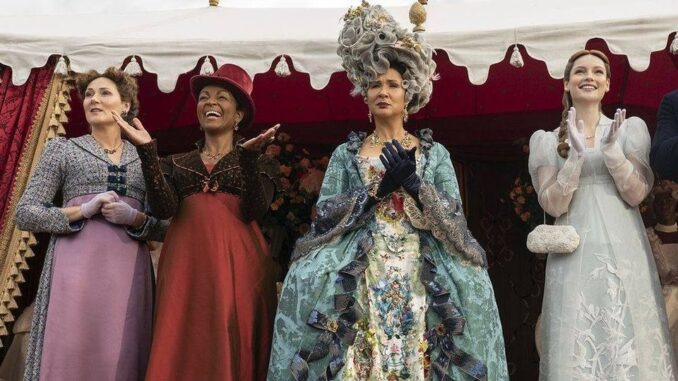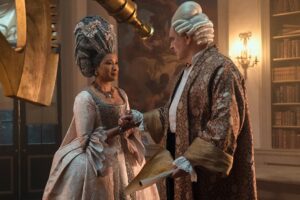
Queen Charlotte: A Bridgerton Story recounts the early life of the real-life royal. But how accurate is the Netflix prequel series?
Double the coronations, double the royal fun.
While King Charles III was officially crowned Britain’s ruling monarch on May 6, it wasn’t the first coronation to be streamed this month. Netflix’s highly anticipated Bridgerton prequel series Queen Charlotte: A Bridgerton Story premiered May 4, inviting viewers to discover the intimate origin of its titular character.
Ironically enough, Queen Charlotte (played by Golda Rosheuvel, who reprises her role from the mothershow, and India Amarteifio as the younger version) wasn’t a character featured in Julia Quinn’s bestselling book series on which the series is based. But, by the power of Shonda Rhimes’ pen, the real-life royal became such a powerhouse force that she landed her own spinoff series.
In its six episodes, fans see how Charlotte went from German princess to British queen, including her complicated relationship with her husband King George III (Corey Mylchreest) and the political, social and racial minefields she navigated as the first Black member of the royal family.
So, what did Queen Charlotte: A Bridgerton Story pull from the real royal’s life? Dearest readers, you might just be surprised…
How Did King George III and Queen Charlotte Meet?
In the prequel series Queen Charlotte: A Bridgerton Story, fans of the Netflix historical drama get to see the origin story of its titular royal—played by Golda Rosheuvel, with India Amarteifio making her Bridgerton debut as the younger version—including her mysterious marriage to King George III.

In the premiere episode, a resistant 17-year-old German princess is sent off to England, where she will become the British queen after marrying George (Corey Mylchreest), whether she likes it or not. Afraid he is “a troll,” Charlotte attempts to escape by climbing a garden wall, only to come face-to-face with her soon-to-be husband. Cutest of meets, no? Alas, it was a figment of Shonda Rhimes’ glorious imagination. In reality, Charlotte, who did not yet speak English, met the 22-year-old George when she was received by the King and his family at the garden gate upon her arrival in England, just six hours before they exchanged vows.
While their wedding was quite lavish on-screen, the real nuptials were only attended by the royal family, the people who had traveled from Germany with the bride and a handful of other guests.
Was Charlotte Really the First Black Queen?
A major storyline throughout Queen Charlotte’s run is the intersection of race and politics within the monarchy as Charlotte is presented as the first Black person to marry into the royal family. To this day, experts still debate the racial origins of Charlotte, with historian Mario de Valdes y Cocom believing her to directly descended from Portugal’s king Alfonso III and his mistress, Ouruana, a Black Moor. However, many academics have countered that there is no genealogical proof to back the claim.
Regardless of the questions surrounding Charlotte’s real-life ancestry, it was important for the show-makers to identify her as a Black woman. “Many historians believe that Queen Charlotte was of mixed cultural heritage,” director Tom Verica told Netflix. “We wanted to take that in a different direction than what the history books have said happened—which was basically to bury that and not deal with it.”
In an exclusive interview with E! News, Tunji Kasim, who plays Charlotte’s brother Adolphus, explained how important it was to have the topic explored on the show.
“It’s fantastic to have a conversation about that,” Tunji said. “It’s especially relevant in the last few months given the Prince [Harry] and [Meghan Markle] situation that’s going on in Britain. Navigating such an institution—such a predominantly Caucasian institution, and proudly so—Queen Charlotte having to navigate that is very much front and center within this story.”
Was King George Mentally Ill?
When George III initially kept Charlotte at a distance after their wedding, it was revealed it is because he is trying to “protect the secrets of the Crown,” which, really, is about his undiagnosed condition. Initially thought to be an “inflamed cerebellum” by one physician, Dr. Monro (Guy Henry) eventually deems that the on-screen George is “merely suffering a disorganization of the nerves.” (Cue many drastic and dangerous treatment scenes.)
In real-life, George is believed to have had a medical condition caused by porphyria. In the 1966 article “The Insanity of King George III: A Classic Case of Porphyria,” mother-and-son psychiatrists Ida Macalpine and Richard Hunter wrote that the royal’s records showed that he suffered from the genetic blood disorder that can cause hallucinations, depression and paranoia.
